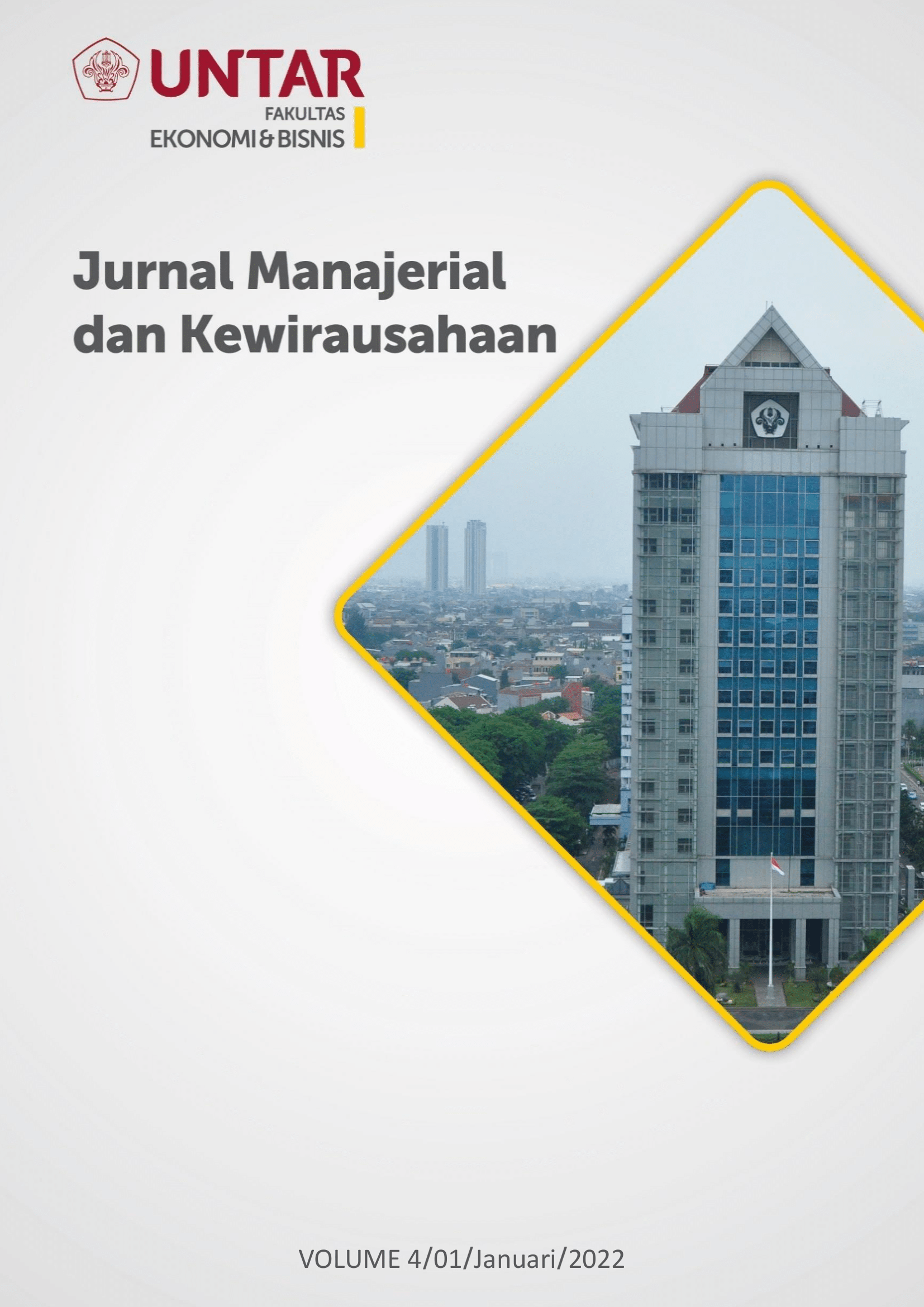Pengaruh Kreativitas dan Efikasi Diri terhadap Niat Kewirausahaan Mahasiswa FEB Universitas Tarumanagara
Main Article Content
Abstract
Penelitian ini bertujuan untuk mengetahui pengaruh kreativitas dan efikasi diri terhadap niat berwirausaha. Penelitian ini menggunakan metode kuantitatif di mana data yang dikumpulkan oleh peneliti menggunakan metode survey dengan platform “google form” terhadap 100 responden yang merupakan mahasiswa Fakultas Ekonomi dan Bisnis Universitas Tarumanagara. Ada dua hipotesis yang akan diuji dengan cara mengkalkulasi data berskala Likert menggunakan PLS-SEM. Pengambilan sampel dilakukan dengan teknik non-probability sampling. Metode analisis data yang digunakan oleh peneliti adalah PLS-SEM yang dikalkulasi melalui software SmartPLS versi 3.3.3 dengan metode bootstrapping guna mengukur tingkat signifikan. Hasil penelitian menunjukkan terdapat pengaruh positif signifikan kreativitas terhadap niat berwirausaha mahasiswa Fakultas Ekonomi dan Bisnis di Universitas Tarumanagara dan terdapat pengaruh positif signifikan efikasi diri terhadap niat berwirausaha mahasiswa Fakultas Ekonomi dan Bisnis di Universitas Tarumanagara.
This study aims to determine the effect of creativity and self-efficacy on entrepreneurial intentions. This study uses a quantitative method where the data collected by the researcher uses a survey method with the "google form" platform on 100 respondents who are students of the Faculty of Economics and Business, Tarumanagara University. There are two hypotheses that will be tested by calculating Likert-scale data using PLS-SEM. Sampling was done by non-probability sampling technique. The data analysis method used by the researcher is PLS-SEM which is calculated through the SmartPLS software version 3.3.3 with the bootstrapping method to measure the level of significance. The results showed that there was a significant positive effect of creativity on the entrepreneurial intentions of students of the Faculty of Economics and Business at Tarumanagara University and there was a significant positive effect of self-efficacy on the entrepreneurial intentions of students of the Faculty of Economics and Business at Tarumanagara University.
Article Details
This work is licensed under a Jurnal Muara Ilmu Ekonomi dan Bisnis Creative Commons Attribution-ShareAlike 4.0 International License.,/p>
References
Aamir, H., Imran, S., Imran, A., & Syed, A. H. (2020). Entrepreneurial intention of Indian university students: the role of opportunity recognition and entrepreneurship education. Education + Training.
Ajzen. I. (2002). Perceived Behavioral Control, Self-Efficacy, Locus of Control, and the Theory of Planned Behaviour. Journal of Applied Social Psychology, 1-20.
Ana, P. R., Filipa, E. J., Carlos, A. P., & Patrícia, A. (2019). The contribution of emotional intelligence and spirituality in understanding creativity and entreprenurial intention of higher education students. Education + Training.
Bandura, A. (1994). Self-Efficacy. Encyclopedia of human behaviour, Vol. 4, 71-81.
Benedetta, B., Veronica, M., & Michela, L. (2017). The power of peers: A new look at the impact of crreativity, social context and self-efficacy on entrepreneurial intentions. International Journal of Entrepreneurial Behaviour & Research.
Betram, D. (n.d.). Likert Scales. ACADEMIA.
Chiayu, T., & Suechin, Y. (2013). The Role of Entrepreneurial Creativity in Entrepreneurial Processes. International Journal of Innovation, Management and Technology, Vol. 4, No.2.
Ghozali, I. (2014). Structural Equation Modeling Metode Alternatif dengan Partial Least Square.
Han, G. H., & Bai, Y. (2020). Leaders can facilitate creativity: the moderating roles of leader dialectical thinking and LMX on employee creative self-efficacy and creativity.
Jin, Y., Hefu, L., & Jibao, G. (2017). A multi-level study of servant leadership on creativity: the roles of self-efficacy and power distance. Leadership & Organization Development Journal, Vol 38(Issue 5).
Joe, F. H., Christian, M. R., & Marko, S. (2011). PLS-SEM: Indeed A Silver Bullet. Journal of Marketing Theroy and Practice, Vol. 19, No. 2, 139-151.
Peterson, M., Mueller, S. L., McGee, J. E., & Sequeira, J. M. (2009). Entrepreneurial Self-Efficacy: Refining the Measure.
Roya, M., Mohammad, R. Z., Mohhammad, H. M., & Jahngir, Y. F. (2014). The impact of entrepreneurial ideas and cognitive style on students entrepreneurial intention. Journal of Entrepreneurship of Emerging Economies, Vol. 6, No. 2, 140-162.
Sekaran, U., & Bougie, R. (2016). Research methods for business: a skill-building approach. United Kingdom: Wiley.
Shahab, Y., Chengang, Y., Arbizu, A. D., & Haider, M. J. (2018). Entrepreneurial self-efficacy and intention: do entrepreneurial creativtiy and education matter? International Journal of Entrepreneurial Behaviour & Research.
Smith, R. M., Sardeshmukh, S. R., & Combs, G. M. (2016). Understanding Gender, Creativity, and Entrepreneurial Intentions. Education + Training, Vol. 58, No. 3, 263-282.
Suphat Sukamolson, P. (n.d.). Fundamentals of quantitative research. Language Institute.
Swati, M., & Rajib, L. D. (2015). Transformational leadership and employee creativity: mediating role of creative self-efficacy and moderating role of knowledge sharing. Management Desicion, Vol 53(Issue: 5), 894-910.
Tenenhaus, M., Amato, S., & Esposito, V. V. (2004, June). A global goodness-of-fit index for PLS structural equation modelling. Proceedings of the XLII SIS scientific meeting, Vol. 1, No. 2, 739-742.
Thundiyil, T. G., Chiaburu, D. S., Li, N., & Wagner, D. T. (2016). Joint effects of creative self-efficacy, positive and negative effect on creative performance. Chinese Management Studies, Vol 10, No.4, 726-745.
Timothy, O. A., Mujidat, O. B., Kahilu, K.-S., Olaitan, W. O., & Rachel, L. (2020). Entrepreneurial intentions of real estate students: an ordinal analysis of the predictors. Journal of Facilities Management.
Wetzels, M., Odekerken-Schröder, G., & Van, O. C. (2009). Using PLS path modeling for assessing hierarchical construct models: Guidelines and empirical illustrarion. MIS quarterly, 177-195.
Wirayawan, Z. Z., & Hidayah, N. (2013). Pengaruh Motivasi, Norma Subyektif dan Efikasi Diri terhadap Niat Melakukan Penjualan pada Tenaga Penjual di Beberapa Mall Jakarta. Karya Ilmiah Dosen, 5-47.
Wiyanto, H. (2014). Pengaruh Efikasi Diri dan Lingkungan Terhadap Niat Berwirausaha (Studi Pada Mahasiswa Program Studi Manajemen Fakultas Ekonomi Universitas Tarumanagara. Jurnal Manajemen, 18, No. 1, 114-129.



